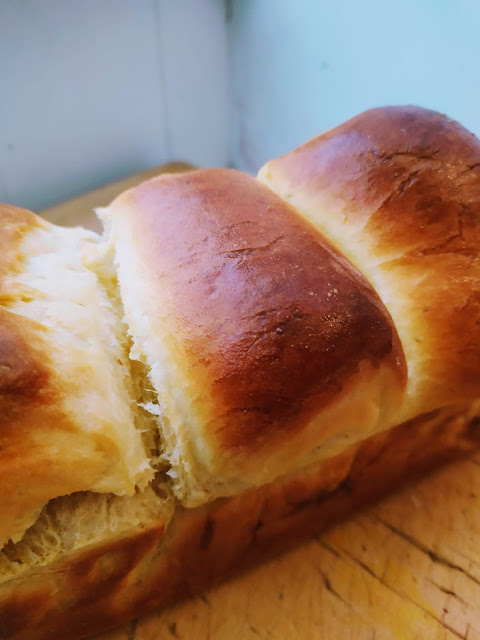French Food Friday - Home made Brioche
We both love brioche and there is nothing nicer than making it yourself. It takes a bit of time but the end result is well worth the effort.
This recipe makes two loaves.
Ingredients
- 6 eggs (at room temperature)
- 1 cup unsalted butter (230g, at room temperature)
- 4 ¾ cups all-purpose flour (620g, divided)
- 1 tablespoon active dry yeast (9g)
- ¼ cup granulated sugar (50g)
- 1½ teaspoons salt (8g)
- ½ cup warm water (120 ml, about 120 degrees F/49 degrees C)
- 2 teaspoons sugar (10g, dissolved in 1 tablespoon/15 ml water)
Instructions
Day 1:
- Take out 6 eggs and 1 cup / 230g butter a few hours before you begin to bring them to room temperature. Prepare all other ingredients before starting.
- In the bowl of an electric mixer fitted with a paddle attachment, mix together 1 cup flour (130g), 1 tablespoon active dry yeast (9g), ¼ cup granulated sugar (50g), and 1½ teaspoons salt (8g), before adding ½ cup (120 ml) warm water (at about 120 degrees F/49 degrees C). Turn the mixer on at medium speed for a couple of minutes until well-combined.
- Now add in 1 egg at a time. Only add the next egg when the previous egg is well incorporated.
- Set the mixer to low. Add in 2 cups of flour (260g), a ¼ cup at a time, and let the mixer go until the dough is well combined.
- Turn the mixer off, and cut the softened butter into small cubes/chunks. With the mixer on medium, add the butter in 6 separate batches, waiting until the butter is well incorporated after each batch before adding more.
- Set mixer to low. Now add in 1 3/4 cups of flour (230 grams), a ¼ cup at a time until the dough is well-combined. This dough will be very sticky (closer to a very thick batter) when it’s done.
- Use a rubber spatula to clean the dough off the mixing paddle, and scrape the sides of the mixing bowl. Cover the dough with a plate or plastic wrap and let it proof at room temperature (about 70 degrees F/21 degrees C) for 3 hours, until it doubles in size.
- After 3 hours have elapsed, punch and deflate the dough completely with a rubber spatula. Cover the dough with a plate again, and refrigerate it overnight until 3 hours before you’re ready to bake the next day.
Day 2:
- Remove the dough from the refrigerator. Divide it into two equal pieces. Shape them on a lightly floured clean surface, and place each into its own loaf pan (loaf pan size: 9" x 5"). The chilled dough is a bit stiffer to work with, so you can use a rolling pin to help shape it into the desired width and length. If you do this, make sure to roll the dough lengthwise like a cigar when you’re done to ensure a rounded top to your loaf. Whatever you do, the dough should fit snugly in the loaf pan.
- Now, you can create plain loaves as I’ve described above, or you could create a braid or individual buns, as pictured.
- Cover each loaf pan tightly with clear plastic wrap, and let proof at room temperature for about 2½ to 3 hours, until doubled in size.
- Preheat the oven to 350 degrees F / 180 degrees C while the dough is proofing. Bake for 37 to 40 minutes in the center of the oven. Tent the loaves with foil if the crust is getting too dark. While it’s baking, prepare the sugar water by mixing 2 teaspoons sugar with 1 tablespoon water until the sugar is completely dissolved. When the bread is done, remove from the oven, and immediately brush the tops of the bread with sugar water to give it that shiny finish.
- Let the brioche sit in the loaf pan for 5 minutes to cool before transferring the loaves from the pans to a cooling rack. This cooling step is important so the bread does not fall apart.
- Once the brioche has cooled completely, you can store it in a tight sealed container or zip-lock bag to keep it fresh. It is best served slightly warm with softened butter.
Bon vendredi à tous, Leeann x

Comments
Post a Comment